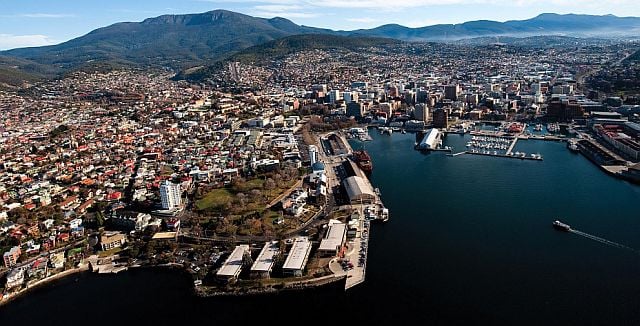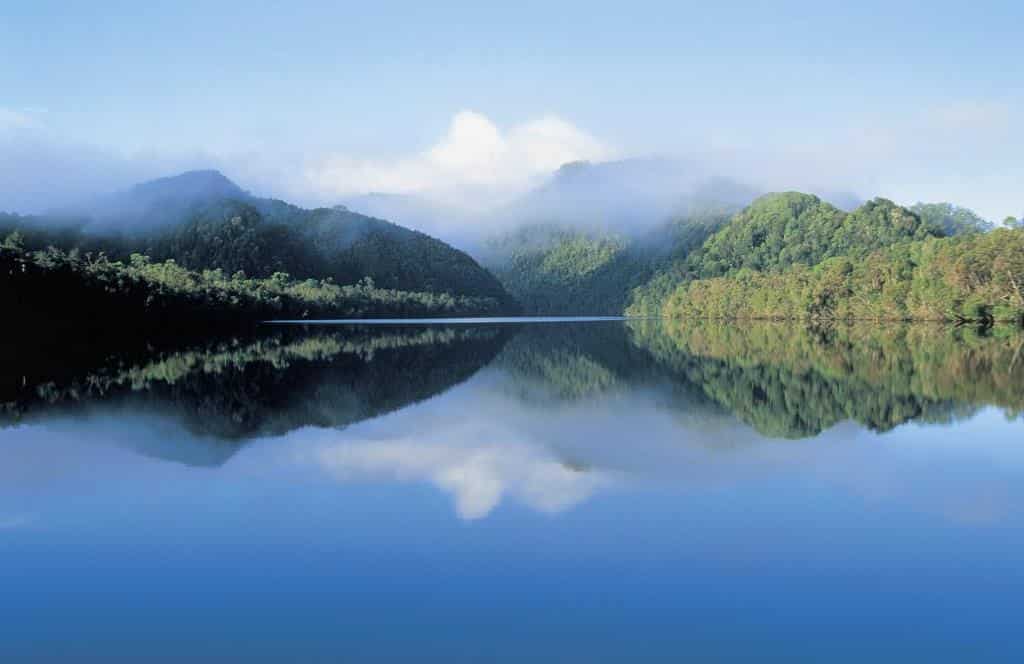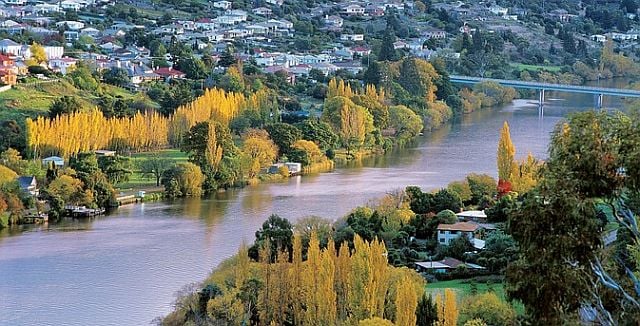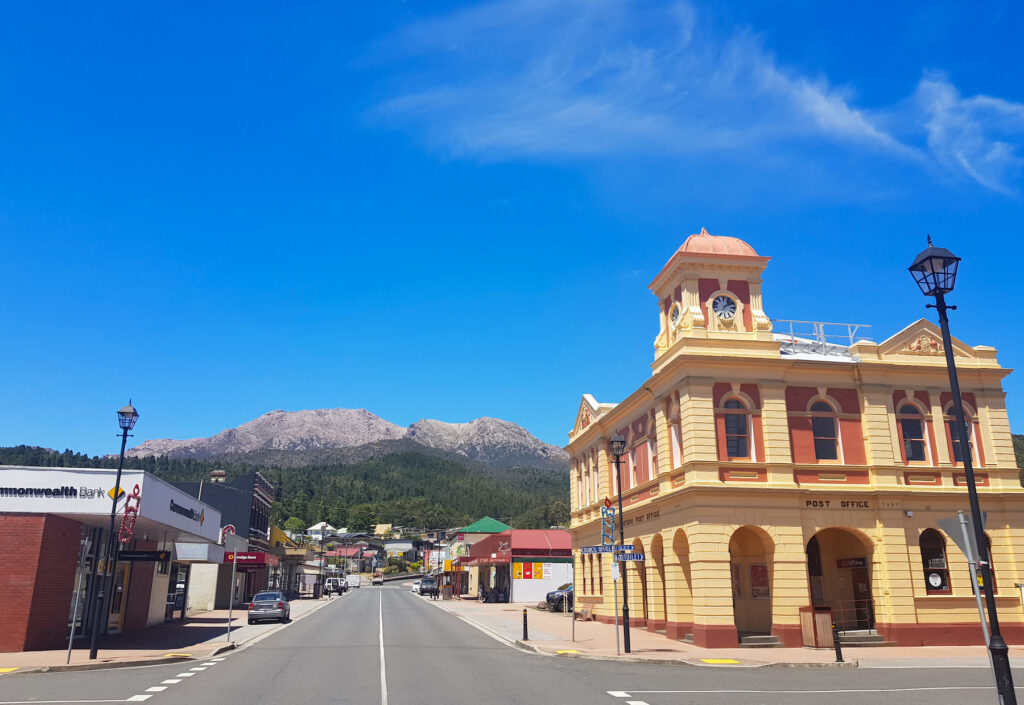Book a departure in April or May 2024 and save $400 8-Day Circle Tasmania Tour.
The Amazing Local History of Tasmania
3 July 2023
For those of us wishing to experience travelling through time but lack a time machine, Tasmania offers a rich and diverse history. One that is experienced through all the senses.
Tasmania, or historically Van Diemen’s Land, is an area ripe with a rich history of our convict past and settlement. Tasmania was the second colony to be established by the British, in 1803. It includes several historical sites that are an experience to behold. These include Tasmania’s first penal colony, established at Macquarie Harbour on Sarah Island, and Hobart’s notorious Port Arthur. From the wonderful and whimsical to the grim and grotesque, the amazing local history of Tasmania can’t be ignored.
Aboriginal History
Historically, the Aboriginal people of Tasmania created art in the form of sand, cave and bark paintings, shell necklaces, stone tools, and baskets. Art objects were used to record stories, connect people to their families, and helped inform the teaching process.
The first Aboriginal art was created by the nomadic tribes of the Big River, Isolation, and Oyster Bay people. Sand and bark paintings were very important. They were used to mark and record important events, share knowledge and arrange spiritual understanding.
After colonization of Tasmania in 1802, the practice of Aboriginal art was viewed as primitive, and any existing art works were destroyed or buried. The art forms were further diminished in the face of relocation to mainlands and the displacement of Aboriginal people.
After many years, the practice of Aboriginal art re-emerged in the 1990s both in the urban and rural areas of Tasmania. The Tasmanian Arts Council, and other Aboriginal organisations, encouraged Aboriginal artists to express their culture through art and help educate the public on the original people of the land. A number of galleries dedicated to showcasing Aboriginal art in Tasmania have been implemented. Events such as the Tasmanian Aboriginal Arts Festival are also held annually to showcase the work of established and new artists.
Many elements of Aboriginal art are still being revived and recognized in Tasmania today. The work of contemporary Tasmanian Aboriginal artists is helping to celebrate and strengthen the ancient practice and share the stories of the original people of the land.
Hobart

It is the capital of Tasmania, a small but beautiful island state located off the south-east coast of Australia. Founded in 1804 as a penal colony, the port offered a gate to the world for the fledgling agriculture industry in Tasmania. As the colony grew, so too did Hobart town. It steadily developed into a bustling regional capital, forging strong bonds with the many diverse communities that have made their livelihood on the island. The city preserves a proud maritime and convict past, and still has a distinctive character that is evident in its many colonial-era buildings, quaint wharves, and diverse surrounding communities. Hobart has grown to be a vibrant hub for arts, culture, and entertainment. It is home to world-renowned museums, galleries, and a thriving arts and culture scene.
The Cascades Female Factory in South Hobart, Tasmania is a former factory and convict institution for women. Built in the early 19th century, it is one of the 11 sites that make up the Australian Convict Sites World Heritage Property, inscribed in 2010. Today, it functions as a museum and is open for public tours. Here you can explore and learn about this unique part of Australian history. You will also have the chance to explore interactive audio-visual displays, learn about some of the most colorful inmates, and gain insight into the significant role of the female factory in the foundation of modern day Australia.
Hobart is the perfect location to base a trip and learn about the local history of Tasmania. From here you can visit top destinations like Port Arthur or Bruny Island for a day trip. Stay in lovely accommodation and enjoy local produce on one of our Hobart day tours.
Mount Wellington

Also known as kunanyi, Mount Wellington is an iconic mountain located just outside of the city of Hobart. Standing at 1,271 metres (4,170 feet) tall it is one of the most spectacular natural attractions of Tasmania’s capital. The area has been the traditional land of the Palawa people who had lived in the region for thousands of years before European settlement in the early 1800s.
Mount Wellington’s popularity increased in the 19th century when Sir John Franklin wrote about the area in his Letters from Van Diemen’s Land. In these letters he described the spectacular views from the top of the mountain. There are an abundance of activities to experience on Mount Wellington. From breathtaking views, to walking, cycling and kayaking trails, as well as a variety of visitors attractions. Mount Wellington is an important part of Tasmania’s natural, cultural and political history, and continues to be an iconic landmark in the state.
Sarah Island
Strahan, located on the western coast of Tasmania, is home to the untouched beauty of Macquarie Harbour. It is here where the British brought their most hardened criminals to Sarah Island which resulted in a penal colony of unimaginable hardship.
The traditional custodians, the Toogee Indigenous Australians, called Macquarie Harbour home for 35,000 years before European arrival. In 1821, a penal colony was established at Sarah Island. A signal station, now a lighthouse, was also established on Cape Sorell to ensure safe traffic through Hells Gates. Aptly named by the convicts who arrived in Macquarie Harbour as many ships that sailed from England had sunk at the mouth of the harbour metres away from their destination.
One of Australia’s and Tasmania’s most notorious convicts, Alexander Pearce, famously made escapes from Sarah Island in 1822 and in 1823. Pearce’s story is surrounded by claims, and an admittance, of cannibalism – yikes!
By around 1830, there was little to none of the Toogee Indigenous population left in the area. By 1833 the penal colony on Sarah Island was closed and the convicts were moved to Port Arthur.
Gordon River

Strahan is also home to the Gordon River. Described by photographer, Olegas Truchanas, as “This vanishing world is beautiful beyond our dreams and contains in itself rewards and gratifications never found in an artificial landscape or man-made objects”. You will be shocked to know that the Gordon River not only provided Truchanas with a sight of beauty, but also served as a tragic end for his story if you find Australia’s gruesome and absurd history to be something that sparks your curiosity. The photographer drowned in the river in 1972. Fortunately Gordon River’s mesmerising beauty can be explored from the comfort and leisure of a cruise, promising an extraordinary experience on the senses, without the grotesque nature of the region’s history.
Cradle Mountain

A well-known and beloved mountain located in the Cradle Mountain-Lake St Clair National Park. It is part of the Tasmanian Wilderness World Heritage Area and stands at 1,545 metres (5,069 ft) above sea level. It is one of the most iconic mountains in Australia and attracts thousands of local and international visitors each year. Formed millions of years ago during the Miocene period it has been a part of the cultural and spiritual ancestry of the Tasmanian Indigenous population for thousands of years.
Early European explorers explored and documented it in the 19th century and it became an integral part of the local community. The Parks and Wildlife Service granted the area National Park status in 1971 and has been managing it since. In recent years, Cradle Mountain has gained attention for its remarkable natural beauty and pristine wilderness areas. Providing numerous recreational opportunities, including walking, mountain-climbing, skiing, and cycling. And best of all, it offers stunning views of the Cradle Mountain-Lake St Clair National Park.
There are many day tours available to explore this wonderful part of Tasmania.
Port Arthur

An easy drive from Hobart, and a place of historical and constitutional importance in Australia. Port Arthur historic site is an experience that you will both see and feel when you visit. This site is truly immersive, leaving you both reflective and curious. It is a location of significant importance in the local history of Tasmania.
Port Arthur, a 19th Century penal settlement, is an open-air museum with many historical sites to visit and to become immersed in. There are several ways to experience Port Arthur. For those looking for guided tours, there are many available from the spooky cemetery tour to a more leisurely viewing of the establishment and history of Port Arthur. At the 1830 Restaurant & Bar consume some of Hobart’s finest produce, including the availability of local wines, craft beers and spirits.
Port Arthur is one of the most popular tourist destinations in Tasmania. This 19th century former convict prison is a significant part of Australia’s history.
Richmond

For those who are looking to enjoy a taste of Tasmania’s history and the local produce, Richmond is your town. Richmond is a short drive outside of Hobart and provides experiences for those looking to dive into the history of Tasmania. It is also a great location if you’re looking for leisurely experiences of divine local produce and some of the regions finest offerings of gourmet dining and wine.
Everyone in Richmond can experience the renowned Georgian architecture and beautiful heritage buildings of the village. Activities and experiences like museums, the Zoodo Zoo, and local markets operating on a Saturday. We recommend visiting Richmond Bridge and Richmond Gaol. For those on a journey focused on the delicacies of the palate, there is several vineyards and dining options.
Oatlands

A small historic town in the Midlands of Tasmania, Australia. British settlers from Norfolk, England founded the town in 1820 and named it after one of the county’s towns. Oatlands’ historic buildings, stone walls, and walking paths attest to its colonial past. The town boasts the whitest limestone cobblestones in the world. Home of a former convict prison, as well as one of the oldest operating grain mills in Australia. Once a thriving agricultural hub, and at one time was home to the largest wool store in the Southern Hemisphere. Today, Oatlands is a popular destination for tourists who come to enjoy its rural charm, explore historical sites, and visit its local markets.
Ross

A beautiful historic township located in central Tasmania, Australia. First settled in 1817 by a British party led by Colonial Administrator Lt. Charles Athol Stewart and John Honey. The town grew as a farming community until the early 20th century when it became an important industrial center for the nearby tin mining industry. The third oldest bridge in Tasmania, marked by 186 convict masons who were awarded their freedom due to its beauty, gives Ross its impressive Georgian-style buildings dating from the 19th century. Furthermore, its magnificent gardens have been restored to their original 19th century glory, ensuring its renown. While in Ross, you can also immerse yourself further in Australia’s convict past by visiting the Ross Female Factory. Today Ross is a popular tourist destination, due to its charming local history of Tasmania, its picturesque landscape, and its many unique attractions.
Coal Mining
Coal mining has a long association with Tasmania. The history began in 1833 when coal was first mined on the island. In the early 20th century, coal mines dotted the island as coal mining grew to become an important part of Tasmania’s economy. However, by the mid-20th century, the industry had declined due to the development of alternative energy sources. Today, only one coal mine remains in Tasmania, Fentonbury Mine. It is located in the northwestern part of the state near the town of Burnie. Established in the 1970s, it is the oldest and largest coal mine in the region. It continues to provide employment to the local community.
World War
Tasmania played an important role in World War One. At the outbreak of the war, Tasmania committed over 12,000 men to the war effort. During the war, Tasmania provided the Australian Imperial Expeditionary Force with men, supplies and support to help with the war effort. Tasmania was heavily involved in the war. Its soldiers served in all major theatres of war. Tasmania’s economy also boomed during the war. This was largely due to the demand for mined ore, timber and produce for the war effort. After the war, soldiers returned to Tasmania and the state aided in the rebuilding of its war-scarred world. The World War was significant in forming the local history of Tasmania.
Bass Strait
Located between mainland Australia and the island of Tasmania, and named after English explorer George Bass. While searching for a suitable route from Sydney, New South Wales to Tasmania in 1797 he sailed through it. Bass Strait has been a major source of freight and passengers for Tasmania since European settlement in 1803. The strait has also been an important source of fishing activity for both Tasmania and mainland Australia. While the smaller Boat Harbour has a history of fishery, it is the larger Macquarie Harbour that has had a greater focus on fishing. The tidal variation of up to 8 metres allows for the migration of many species, especially shellfish.
Tamar Valley

Located in the northern part of Tasmania and covering a large portion of the Tamar River, the valley holds a long and interesting history. The Palawa Aborigines initially inhabited the Valleys until 1804, when the first British settlers started arriving. After a gradual increase in settlement, the region became an important agricultural and commercial centre. It was a part of the commercial hubs of Launceston and Devonport in the 19th century. Tamar Valley became a centre for the timber industry. Sawmills utilised the abundance of tall Eucalypt trees to supply Tasmania and the rest of Australia with wood.
It is known for it’s incredible produce and growing methods, being awarded a Protected Geographical Indication (PGI) for its Tasmanian produce. The valley has become an increasingly popular tourism destination, thanks to its winery scene, historic sites, walking trails, fishing spots and picturesque scenery.
New Norfolk
Home to some of Australia’s oldest buildings, including St Matthew’s Anglican Church (1823) and the Bush Inn, which has been continuously licensed since 1825. If you’re interested in Australia’s spirited sites or looking to quench your thirst, the Bush Inn is the perfect experience, as it is thought to be haunted (including hidden underground tunnels).
Willow Court, once a military hospital before being used as a mental health institution, is now the home to several antique stores, hospitality venues, and a small community market on Sundays. Nestled amongst elegant, landscaped gardens, Salmon Pond, is the oldest rainbow and brown trout farm in Australia and caters to horticulturalists and gardening enthusiasts.
Stanley

A historic town on the north-west coast. Known for its unique geological features including ‘The Nut’, a large mound of volcanic basalt rising from the sea. First settled in the early 1800s, quickly becoming an important port for whalers and the whaling industry. It developed into a fishing and forestry town in the late 1800s, until it became a major tourist attraction. With its beautiful views, stunning coastline, and historic buildings it is no wonder why. With a number of heritage-listed sites, such as the Highfield Mansion and the Stanley Park Historic Precinct. In 1977, they declared it a historic town and it still remains a popular tourist destination today.
Launceston

In Tasmania’s north, Launceston is the perfect place for any appassionato di vino. With a perfect mix of the traditional and contemporary with a rich history and peaceful atmosphere. Appealing to those interested in the region’s history, natural beauty, and divine local produce.
Apart from the wine, Launceston offers some of Australia’s best-preserved architectural heritage and is Australia’s third oldest city. Initially recognised as a municipality in 1852 as Patersonia. Settled by a British garrison led by Lieutenant Colonel William Paterson.
We recommend visiting Launceston Town Hall. Here you’ll find mayoral portraits of Alderman Button (1853) and every Mayor since, displayed in the formal foyer. While on your journey through Launceston’s rich history, why not explore the Queen Victoria Museum and Art Gallery. Offering educational exhibits and interactive events for visitors of all ages. Visitors can immerse themselves in Tasmania’s colonial past and even learn more about Tasmania’s historical connection with China.
Once you have immersed yourself in Launceston’s history, you can explore the beauty of this city. The main scenic attraction is Cataract Gorge. It is the perfect place to take a leisurely walk, hike, swim, or to just take in the view.
Launceston day tours are a great way to see all the attractions that Launceston has to offer. Explore the famed Cataract gorge, or visit the sculpted gardens. This riverside city has wonderful panoramic views and walking trails, but the Queen Victoria Museum is perfect for you if you prefer emerging in some culture.
Queenstown

Enclosed by Mount Owen and Sedgewick, Queenstown is immersed in history and beauty, with the mountains becoming emblazoned with pink and orange during sunset.
Queenstown was once one of the world’s richest mining towns and has several historic and natural sites to explore. As the town is surrounded by mountains, it needed a way to move their mining material to neighbouring towns on the west coast, such as Strahan.
This railway, known as the West Coast Wilderness Railway, conceptualised to promote investment from those in London, commenced in 1893 and was in use till 1963. However, thanks to lobbying by the locals, the West Coast Wilderness Railway has operated as a tourist attraction since 2002 and provides the opportunity for guests to ride on one of the three ABT steam trains, dating 1896 (ABT1), 1898 (ABT3), and 1938 (ABT5).
While in town visit the Empire Hotel, which represents the town’s significant wealth during its mining days, with a historic hand carved Tasmanian blackwood staircase and architectural beauty that only Michelangelo could depict.
Visitors should also check out both the Galley Museum housed in Queenstown’s first brick hotel (the elegant Imperial, 1898) and Spion Kop Lookout, which provides a magnificent view over town. For those interested in the Aussie Rules, you may also wish to stop by the town’s gravel football oval, The Gravel. Yes! The local teams play on gravel that is smoothed out by bulldozers, this is a site to behold and certainly one method to strengthen the team.
Maria Island

Locate in the north-east of Tasmania, the first mariners to reach Maria Island were the Dutch, who sighted the island in 1642. The French followed in 1772, naming it Ile de Marias and mapping the island. In March 1773, the British expedition commander Tobias Furneaux named it Maria Island after the wife of British King George III. Many years before settling the island in 1788, the French hunted fur seals and whales and, for many years after, the British used the island as a penal settlement from 1825. It was one of the harshest convict systems in the British Empire at the time.
The convicts drew timber, limestone and slate from the island’s rich natural resources. During this time, thousands of convicts passed through Maria Island, creating a rich history of conflict, punishment, brutality and hardship. The Australian government then took control of the island and, in 1905, established one of the first national parks in Australia. In the mid-1970s, people dedicated the island as a wildlife sanctuary, and in 1995 UNESCO named it a world heritage area.
Maria Island is a natural wildlife sanctuary and off-shore retreat with historic ruins, sweeping bays, dramatic cliffs and plenty of stories to tell. Wombats can be seen around the island, as well as pademelons, Forester Kangaroos, Bennetts wallabies and Tasmanian Devils. Located off Tasmania’s east coast and accessible only by ferry, Maria Island contains the most intact example of a convict probation station in Australia. Take a look at the day tours available to visit this magical place full of history.
Huon Valley

With a rich history, dating back to the 19th century, the area was once the home of the Oyster Bay Tribe, who named it ‘Woman’s Paradise’. It was named such for its abundance of fruits and vegetables. Matthew Flinders explored the area in 1792, and the French later settled and developed it The Huon Valley has a rich agricultural history developing as a centre for market gardening, timber milling, fishing, oyster farming and ship-building. People have renowned the area today for its fruit production, including apples, pears and cherries, as well as its wine industry. Huon Valley also has a booming tourism industry, with its stunning landscapes, rich culture and local arts and crafts market attracting visitors from around the world. Its unique history has made Huon Valley one of Tasmania’s most celebrated regions.
Royal Tasmanian Botanical Gardens

First established in 1818 by Lieutenant Governor David Collins as one of the original settlement gardens of Tasmania. The Gardens were initially known as the Queen’s Domain and the plants were initially collected from natural habitats. In 1866, someone appointed the first director and continued to develop the Gardens throughout the 19th century. The Royal Tasmanian Botanical Gardens (RTBG) was officially opened by the Prince of Wales, later to become King Edward VII, in 1901. Since then, the Gardens have grown to include a variety of collections and displays. The Upper Gardens are home to ornamental plantings, while the Lower Gardens feature a range of native species from Tasmania and New Zealand.
The extensive rock garden is one of the highlights of the RTBG. It depicts scenes of the high country of Tasmania with more than 1,000 species of alpine and sub-alpine plants. The Gardens also host a range of events throughout the year, including story time, art and craft classes and guided walks. The RTBG is the host of the prestigious Regional Prize of the Australian Institute of Landscape Architects (AILA) and the recipient of the Keep Australia Beautiful ‘Tidy Towns’ award for the best managed parklands in Tasmania. The Gardens are also home to the groundbreaking Australia-China Friendship Garden, a collaboration between the two nations celebrating 60 years of diplomatic relations. The RTBG is an important part of Tasmanian history and continues to be cherished by locals and tourists alike.
Derwent
A small rural community located on the Derwent River in Tasmania, Australia. Founded in the early 1800s, it is the oldest settlement in the region and has a long and fascinating history. It is home to some of Tasmania’s earliest and most successful pioneer settlements, as well as the nearby towns of Bothwell and Dover. The area is known for its agricultural, pastoral and commercial activities, as well as its fishing and hunting.
Over the years, the Derwent River has provided ample opportunity for recreational activities such as swimming, sailing, kayaking, fishing, and boating. Derwent is a popular tourist and residential destination, thanks to its proximity to several national parks and forest reserves, including Mount Field National Park, Great Lake Conservation Area and the Tasmanian Wilderness World Heritage Area.
Today, Tassie is home to a varied and diverse population of nearly 500,000 people. The island is well known for its stunning landscapes, unique wildlife and immersive cultural experiences. Tasmania is also home to some of the oldest and most remarkable attractions and local history in Australia. Beyond history, Tasmania is filled with incredible natural attractions. Bruny Island features the stunning White Beach and amazing views of Cape Bruny Lighthouse. Visitors can also explore Wineglass Bay in Freycinet National Park, where ancient pink granite peaks meet the stunning turquoise of the Tasman Sea. So book your tour of Tasmania today for the perfect mix of natural beauty and local history.